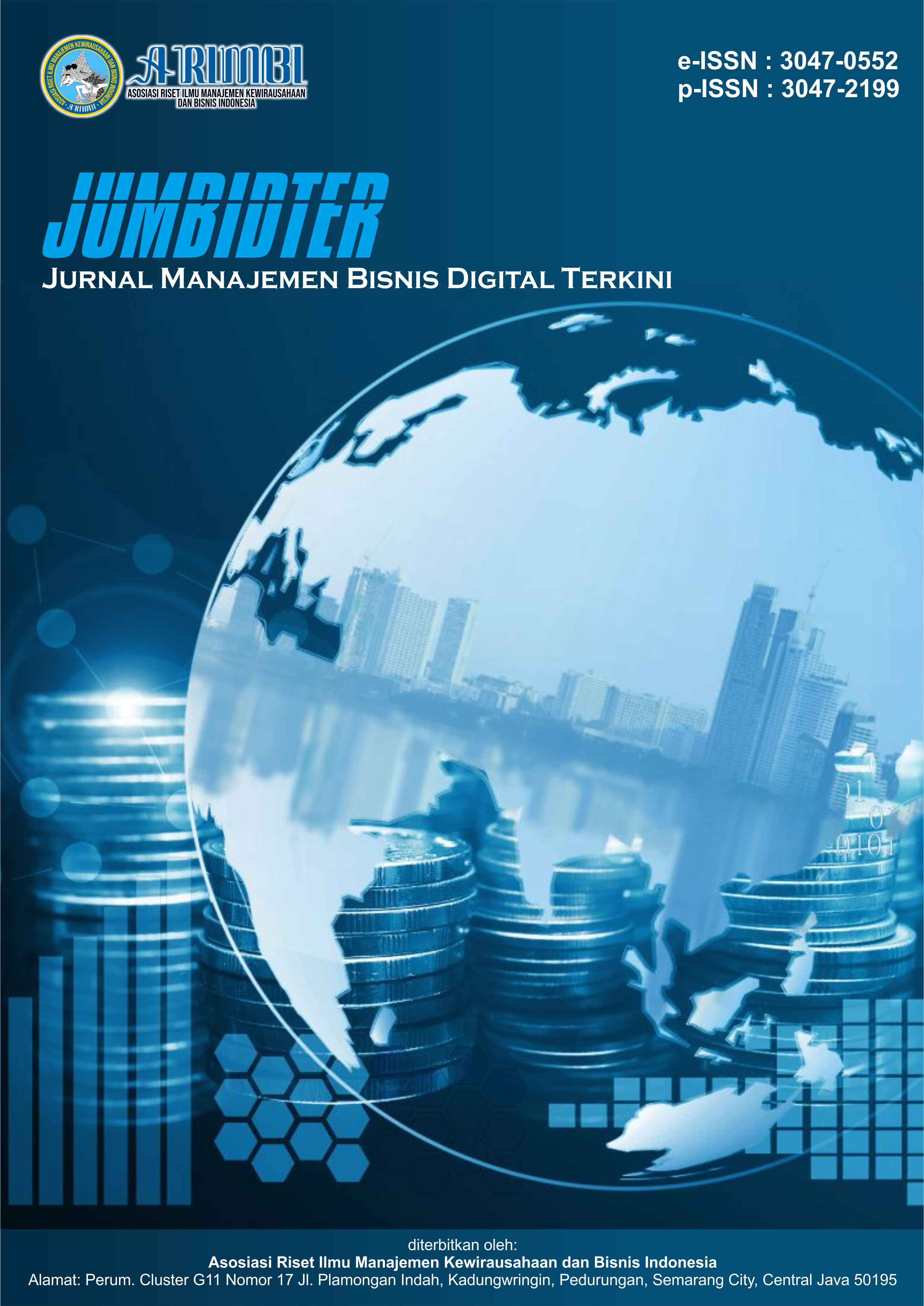Pengaruh Persepsi Manfaat dan Kemudahan Penggunaan QRIS terhadap Keputusan Penggunaan GoPay Melalui Kepuasan Pengguna sebagai Interverning pada Mahasiswa
Studi pada Perguruan Tinggi Swasta di Kota Malang
DOI:
https://doi.org/10.61132/jumbidter.v2i3.692Keywords:
Ease of Use, GoPay, Perception of Benefits, QRIS, User SatisfactionAbstract
Digital transformation in the payment system in Indonesia is experiencing rapid development, especially with the presence of the Quick Response Code Indonesian Standard (QRIS) which facilitates digital transactions in various sectors. One of the most popular digital wallet platforms and widely used by students is GoPay. This study aims to analyze the influence of the perception of benefits and ease of use of QRIS on GoPay usage decisions, with user satisfaction as an intervening or mediation variable. The research was conducted on students from private universities in Malang City using a quantitative approach with an explanatory design. A total of 73 respondents were selected using a simple random sampling technique and the data were analyzed using the Partial Least Square, method using the Technology Acceptance Model (TAM) theoretical framework as a theoretical foundation. The results of the analysis show that the ease of use of QRIS significantly affects students' decisions to use GoPay. This is indicated by a t-statistical value that exceeds the significance threshold of 1.96. However, the perception of benefits has not been shown to have a significant influence on usage decisions. In addition, the results of the mediation test showed that user satisfaction played a significant role as a mediator in the relationship between ease of use and GoPay usage decisions. In contrast, user satisfaction does not mediate the relationship between benefit perception and usage decisions. The implications of these findings emphasize the importance of developing a simple and intuitive user interface and user experience. Digital payment app developers are advised to focus on improving the usability aspect in order to encourage loyalty and repeat decisions from young users. This research makes an important contribution to the literature on the adoption of digital technology and the behavior of younger generation users in the era of digital transformation.
Downloads
References
Alfani, & Ariani. (2023). Pengaruh persepsi manfaat, persepsi kemudahan, risiko dan kepercayaan terhadap keputusan menggunakan uang elektronik (QRIS). Edunomika, 8(1), 1–8. https://jurnal.stie-aas.ac.id/index.php/jie/article/view/11256
Ambarwati, D. (2019). Pengaruh persepsi manfaat, persepsi kemudahan dan persepsi kepercayaan terhadap keputusan penggunaan GoPay pada mahasiswa STIE AUB Surakarta. Jurnal Bisnis dan Ekonomi, 6(1), 88–103.
Brown, E. D., Lee, H., Scott, D., & Cummings, G. G. (2014). Efficacy of continuation/maintenance electroconvulsive therapy for the prevention of recurrence of a major depressive episode in adults with unipolar depression: A systematic review. The Journal of ECT, 30(3), 195–202.
Chuttur, M. (2009). Overview of the Technology Acceptance Model: Origins, developments and future directions. Sprouts: Working Papers on Information Systems, 9(37), 1–23. https://doi.org/10.1021/jf001443p
Davis, F. (1989). User acceptance of information systems: The Technology Acceptance Model (TAM). Division of Research School of Business Administration.
Davis, F. D. (1989). Perceived usefulness, perceived ease of use, and user acceptance of information technology. MIS Quarterly, 13(3), 319–339. https://doi.org/10.2307/249008
Ghozali, I., & Latan, H. (2025). Partial least squares: Konsep, teknik dan aplikasi menggunakan program SmartPLS 3.0 untuk penelitian empiris (4th ed.). Badan Penerbit UNDIP.
Hajar, T., Lubis, P., & Roihan, M. (2024). Analisis pengaruh persepsi kemudahan dan persepsi manfaat terhadap kepuasan pengguna QRIS sebagai layanan digital pada mahasiswa pengguna QRIS di Universitas Jambi. Bertuah: Journal of Shariah and Islamic Economics, 5(1), 112–117. https://www.ejournal.kampusmelayu.ac.id/index.php/Bertuah/article/view/785
Komdigi. (2025). Manfaatkan peluang ekonomi digital, Menko Perekonomian: Jadi pemain bukan target pasar. https://www.komdigi.go.id/Berita/Berita-Pemerintahan/Detail/Manfaatkan-Peluang-Ekonomi-Digital-Menko-Perekonomian-Jadi-Pemain-Bukan-Target-Pasar
Koswara, A. (2024). Pembuatan dan pengelolaan metode pembayaran QRIS pada UMKM Ayam Goreng Teh Iwin di Cileunyi–Bandung. Jurnal Pengabdian Masyarakat STIE Surakarta, 3(2), 304–312.
Madjid, Z. (2025). Transaksi QRIS tap tembus Rp 3,24 miliar sebulan setelah diluncurkan. CNBC Indonesia. https://www.cnbcindonesia.com/market/20250425133218-17-628739/transaksi-qris-tap-tembus-rp-324-miliar-sebulan-setelah-diluncurkan
Mawardi, T. F. R., & Probowo, B. (2023). The influence of perceived benefit, perceived convenience and trust on the decision to use the DANA e-wallet application (Study on UPN Veterans East Java FISIP Students). Management Studies and Entrepreneurship Journal, 4(4), 3733–3741. http://journal.yrpipku.com/index.php/msej
Moore, G. C., & Benbasat, I. (2023). Development of an instrument to measure the perceptions of adopting an information technology innovation. Information Systems Research, 2(3), 192–222.
Ningsih, H. A., Sasmita, E. M., & Sari, B. (2021). Persepsi risiko terhadap keputusan menggunakan uang elektronik (QRIS) pada mahasiswa. Jurnal IKRA-ITH Ekonomika, 4(1), 1–9.
Nugrahaningrum, K. F., & Raharja, E. (2025). Pengaruh persepsi manfaat, kemudahan penggunaan, kepercayaan terhadap keputusan menggunakan QRIS dengan sikap sebagai variabel intervening [Doctoral dissertation, Universitas Diponegoro].
Oliver, R. L. (1980). A cognitive model of the antecedents and consequences of satisfaction decisions. Journal of Marketing Research, 17(4), 460–469.
Putra, D. D. S. (2024). Pengaruh persepsi manfaat dan kemudahan penggunaan terhadap keputusan penggunaan QRIS (Studi kasus pada masyarakat Kota Madiun). Seminar Inovasi Manajemen Bisnis dan Akuntansi (SIMBA) 6 Fakultas Ekonomi dan Bisnis Universitas PGRI Madiun, 269–277.
Putri, N. M. E., & Andarini, S. (2022). Pengaruh self-control dan financial attitude terhadap financial management behavior pengguna layanan Buy Now Pay Later. Jurnal Ekonomi Akuntansi dan Manajemen, 21(1), 60–74. https://doi.org/10.19184/jeam.v21i1.30594
Rachman, A. (2025). Dipermasalahkan AS, transaksi QRIS ternyata meroket 169%. CNBC Indonesia. https://www.cnbcindonesia.com/market/20250423150146-17-628156/dipermasalahkan-as-transaksi-qris-ternyata-meroket-169
Ramadhan, D., Asri, H. R., Gisijanto, H. A., Hartanti, N. D., & Setyarini, E. (2023). Pengaruh persepsi kemudahan, persepsi manfaat, gaya hidup dan literasi keuangan digital terhadap keputusan penggunaan QRIS pada generasi muda. Revenue: Lentera Bisnis Manajemen, 1(04), 162–170. https://doi.org/10.59422/lbm.v1i04.168
Venkatesh, V., & Davis, F. D. (2000). Theoretical extension of the technology acceptance model: Four longitudinal field studies. Management Science, 46(2), 186–204. https://doi.org/10.1287/mnsc.46.2.186.11926
Downloads
Published
Issue
Section
License
Copyright (c) 2025 Jurnal Manajemen Bisnis Digital Terkini

This work is licensed under a Creative Commons Attribution-ShareAlike 4.0 International License.





